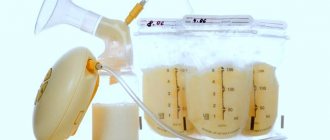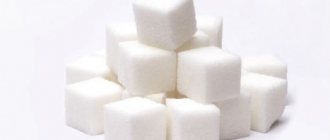Home › From 1 to 3 › Nutrition
You have a baby and you, like a good mother, are fighting for breastfeeding with all your might. And now there are no more problems with feeding, everything is stable and pleasant, and in the meantime your child is growing. And here you are faced with another problem - how long to breastfeed and how relevant is this if your child is already more than 1 year old.
Composition of breast milk
During lactation, only the quantitative composition of milk changes, the quality remains unchanged. At the same time, the water concentration in it remains constant – 85-87%. This food 100% satisfies all the child’s needs, so modern pediatrics supports the principle of feeding on demand. In this case, there is no need to feed and supplement the baby additionally.
In this case, the baby is protected from dehydration and quenches thirst as needed. The water in breast milk does not contain carbonates and salts and has antibacterial properties.
Types of breast milk
Initially, after childbirth, the mother produces colostrum , then it is replaced by transitional milk, and then by mature milk . The composition of these liquids is different.
Colostrum has the most nutrient-dense composition (produced within 1-3 days after birth). It contains minerals, vitamins, hormones and enzymes. Its physicochemical properties are close to those of blood. The concentration of nutrients in the milk then changes. At 4-15 days after birth it is called transitional, and from 16-20 days - mature. Its composition stabilizes, remaining unchanged until the end of feeding the child.
Table 1 - Composition of breast milk in the first month
| Nutrients, per 100 ml: | Colostrum (days 1-2): | Transitional (1-2 weeks): | Mature (from 3 weeks until the end of lactation): |
| Protein, g | 2,3-5,5 | 1,6-2,1 | 0,9-1,5 |
| Fats, g | 2,8-4,1 | 2,9-3,5 | 3,9-4,1 |
| Lactose, g | 4-7,7 | 5,7-6,8 | 7,3-7,6 |
| Retinol, mg | 0,06 | 0,09 | 0,06 |
| Tocopherol, mg | 1,5 | 0,9 | 0,2 |
| Calcium, mg | 48 | 46 | 35 |
| Sodium, mg | 55 | 35 | 17 |
The concentration of proteins in breast milk gradually decreases, by the end of the first year it is 1.5 g per 100 ml. This amount is sufficient for the metabolism of the baby’s cells, normal growth and weight gain. Regardless of the nursing mother’s menu, the baby receives the required amount of nutrients from her milk.
Diagram: composition of a woman's breast milk
The amount of fat in mature milk varies slightly and is 3.9-4.1 g per 100 ml. The structure of breast milk fats is unique. It is saturated with triglycerides, which the baby’s digestive tract absorbs 100%.
The mother's diet affects the fat value of breast milk. It is recommended to exclude sweets, fried and baked foods. After consuming such products, the milk becomes viscous and is difficult for the baby to suck out.
The lactose concentration gradually increases: by 6 months - up to 7 g per 100 ml, by 12 months - up to 7.6 g. Milk sugar is required by the growing body for the development of mental abilities and the nervous system. Half of the lactose is spent on the development of motor skills, 65% on neuronal functions.
The content of microelements and vitamins in breast milk is 1-1.2% and directly depends on the diet of the nursing mother. The more a woman consumes vegetables, fruits and seafood in balance with the main menu, the more her milk is saturated with biologically active substances.
By 18 months, the content of essential nutrients drops sharply by 3 times, reducing the value of breastfeeding. This type of milk is called involutive milk. Therefore, it is recommended to wean a child from the age of one and a half years.
What benefits does long-term breastfeeding give to a woman?
Lactation allows the female body to rest a little, as it suppresses ovulation. Milk production requires 400-600 calories daily, so it helps in losing excess weight gained during pregnancy. In addition, long-term breastfeeding reduces the risk of breast and ovarian cancer by 54%.
Establishing breastfeeding in the first month of a child’s life is not always easy, and to maintain it, the woman needs adequate nutrition and, if possible, the absence of stress. Often mothers are worried about false breast refusal or low weight gain.
At the Healthy Generation MA you can get competent advice from a pediatrician who will answer all your questions about breastfeeding. Contact us!
Calorie content of breast milk
The calorie content of milk also changes according to the baby's needs. Thus, the energy value of mature milk is half that of colostrum.
Table 2 - Amount of calories in breast milk
| Energy value per 100 ml: | Colostrum: | Transitional: | Mature: |
| kcal | 100-150 | 70-75 | 65-70 |
There are times when a baby does not gain weight well with regular meals. Then it is recommended to estimate the calorie content of milk. More often, mothers determine fat content by eye: they express the milk, let it sit for 6 hours and evaluate the color and consistency. A watery white liquid confirms the low calorie content of the product. If the milk is yellow, the walls of the bottle have a greasy coating - the energy value is normal.
You can accurately determine the calorie content of milk using a laboratory method in special clinics. The liquid is collected in a test tube and sent for analysis. The result is ready on the day of delivery, the form indicates the percentage of fat content in 1 mm of the creamy layer (the normal value is 1%).
"Foremilk" and "hind" milk
Expert opinion
Sokolova L. S.
Pediatrician of the highest category
A common cause of underweight in infants is feeding with so-called “foremilk.”
The composition of the fluid in the excretory ducts of the mammary gland differs depending on its location. Closer to the exit channels, the milk is liquid and non-caloric. It is released in the first 10 minutes of feeding and contains a lot of lactose, proteins and a small amount of fat. We can say that the child “gets drunk” with this milk.
Thick, high-calorie hindmilk is concentrated at the base of the glandular ducts. It contains a lot of protein and fat. This is the main food that the baby eats up. It begins to be produced 10 minutes after the start of feeding. It is more difficult for a baby to suck out hind milk than fore milk.
Hind milk feeding technique
In order for the baby to receive not only foremilk, but also hindmilk, you need to:
- feed him on demand, not on a schedule;
- Give only one breast at each feeding;
- The duration of feeding should be from 20 to 40 minutes. If the baby falls asleep after sucking for 10 minutes, you need to carefully wake him up and offer the same breast again;
- massage your breasts 3-5 times a day, preferably before feeding;
- express milk for two minutes before starting a meal;
- choose poses when the breasts hang over the baby.
If the mother is sure that the baby reaches hindmilk, but the problem of underweight persists, it is better to take a test to assess fat content. If the indicator is below 1% in 1 mm of the creamy layer, breastfeeding consultants recommend menu correction.
Products to increase the calorie content of milk
To increase the energy value of milk, mothers are recommended to add the following products to the menu:
- lean meat - turkey, chicken, rabbit;
- walnuts – up to 50 g per day;
- hard cheese;
- cottage cheese;
- butter;
- seafood;
- cereals (buckwheat, oatmeal);
- vegetables - broccoli, cauliflower, salad.
Products are introduced into the diet carefully, taking into account the recommended norms for breastfeeding and the risks of allergies. Overeating will cause excessive fat content in the milk, which can lead to colic and bloating in the baby.
Breast milk after one year. To feed or not to feed?
“You need to breastfeed for as long as possible” VS “Breastfeeding is beneficial until the baby’s first birthday. After this, the milk loses its beneficial properties, becomes a pacifier and psychologically exhausts both mother and baby . Where is the truth?
Together with experienced specialists and mothers of babies, let's figure out how long you should leave your baby breastfed.
ABOUT THE ADVANTAGES: “USEFUL SUBSTANCES FROM BREAST MILK ARE EASILY ABSORBED BY THE CHILD’S BODY”
Even manufacturers of artificial formula admit: their product, although the most expensive and high-quality, cannot be compared with breast milk. Nature is amazingly smart: she has endowed mother's milk with a whole complex of useful microelements. These are proteins, including immunoglobulins, essential amino acids, minerals and vitamins.
Yulia Plotnikova, lactation consultant, perinatal psychologist, mother of four children:
“One gram of lactoferrin contained in breast milk is valued very highly today and costs several thousand dollars. This is an amazing substance that boosts immunity and helps cope with diseases. After a year, and even after 2-3 years, the composition of milk does not change. It adapts to the child in an amazing way. The composition of milk depends on the time of year and duration of lactation. Breast milk contains a lot of vitamin C, carbohydrates, proteins, and all this is easily absorbed by the baby’s body.
Of course, all children get sick: both those who are breastfed and formula-fed babies. But breastfed children still get sick less: statistics show this, and doctors confirm this. Almost all pediatricians, gynecologists, and psychologists support the idea of breastfeeding, including long-term breastfeeding. From a psychological point of view, the feeding process is also very important: it includes hugs, skin-to-skin contact, and the feeling of mother’s heartbeat.
According to my personal observations, children who are breastfed after a year are more responsive, gentle, friendly and easier to communicate with.
However, for breastfeeding, including long-term breastfeeding, to have only positive consequences, it is necessary that the mother feeds with pleasure and has a positive attitude towards feeding. It is important that she attaches the baby with love and tenderness, not through force. I am for conscious breastfeeding: a mother should have a positive or at least neutral attitude towards feeding.
Many modern pediatricians also support the idea of “long-term feeding”. Doctors say that long-term breastfeeding strengthens the baby’s immunity, prevents allergies, improves digestion and even protects against caries.
Anna Ganina, pediatrician, mother of three children:
— There are studies showing that as a child ages, milk adapts to his needs—the balance of fats and calorie content changes. It is from mother's milk that many vitamins and microelements are best absorbed. Milk contains substances that stimulate brain development. And these substances cannot be reproduced artificially.
Immunoglobulins and other substances and even living cells in mother's milk are irreplaceable, helping to protect the child from infections.
All of the above works both at 2 months and at 2 years.
Sometimes mothers say that their child is on formula and is not sick at all, but the neighbor’s child is always “covered in snot”, even though he has been suckling for the second year. But such comparisons are not at all scientific. And it is very likely that a child who is breastfed and often suffers from ARVI would often suffer from pneumonia and otitis media without it. Which is much worse.
Most often, difficulties with breastfeeding after a year are associated with problems in the relationship between mother and child. Babies often demand breastfeeding and begin to act up. But this can be corrected with education and love.
I have three children. I fed my firstborn until he was one year and 9 months old, the middle one until he was 3 years old, the youngest is almost two years old, and I am still breastfeeding him. It's not always easy for me. But everything I know, as a pediatrician and mother, speaks about the benefits of breastfeeding both before and after a year.
"CRY BUT FEED." ABOUT THE MINUSES.
However, there is a theory that breast milk is useful and irreplaceable only in the first year of a child’s life. According to some doctors, there are disadvantages to breastfeeding after a year, which many try not to talk about because of the well-established postulate: “you need to feed as long as possible, no matter what.”
Psychologists are sure: some mothers are driven into a corner by public opinion and adhere to the advice: “Cry, but feed” and “Think about the child and be patient.”
Opinion of an obstetrician-gynecologist
Tatyana Vinogradova, gynecologist at one of the Moscow clinics, ultrasound diagnostics doctor, doctor of the highest category with 23 years of experience, mother of three children:
— The World Health Organization recommends breastfeeding a child until 2 years of age. It is impossible to say unequivocally about the harms or benefits of breastfeeding after a year. Every woman must decide this question independently. If the woman and child are comfortable, then you can safely breastfeed for up to two years and even longer. If the mother experiences discomfort, physical or emotional, she should not torture herself, since this will not benefit the child.
I think that for the baby the psychological state of the mother is much more important. There are mothers who were unable to feed in the first months, this does not mean that there is something wrong with their children. In general, whether or not to breastfeed a child is a personal matter for every woman, the main thing is that the mother loves her child.
For me personally, the question “to breastfeed or not to breastfeed” has never arisen. My three children were breastfed for a long time, from one and a half to two and a half years.
As for the composition of breast milk after a year, it really changes a little, and this is due to the number of feedings. Milk increases fat content, the amount of immunoglobulin A, antibodies, and lactoferrin.
Pediatrician's opinion
Tatyana Kosyakova, a pediatrician with more than 34 years of experience, candidate of medical sciences, works in one of the capital’s clinics:
— According to WHO recommendations (2002), breastfeeding is recommended until the age of two. It is believed that breastfeeding in the second and third years of a child's life reduces the incidence of intestinal infections.
In Russia, breastfeeding up to 1 year was previously considered traditional.
In recent years, according to domestic researchers, about 20% of children receive breastfeeding up to 2 years of age.
Currently, Russian pediatricians and psychologists recommend breastfeeding a child up to 1.5 years of age.
According to authoritative pediatrician and nutritionist Igor Kon, when breastfeeding children over one and a half years old, the problem of excessive attachment of the child to the mother arises. At an older age, this leads to a lack of independence in the child and poor contact in games with other children.
The mother's lactation gradually decreases, which makes it possible to wean the child from the breast within 2-3 months. During this period of a child’s life, psychologists recommend the infant drawing technique. It should be noted that the period of weaning is individual for each child.
Breast milk even after one year contains substances that are significant for the child, this is an indisputable fact. These include immunoglobulins (protection against various infections: viral, bacterial, parasitic), and hormones that control the growth and development of the child, prebiotics and probiotics, various vitamins and microelements. After a year, only the percentage of these substances can change. Therefore, I can say with confidence that even after a year of feeding, the child receives useful elements in sufficient quantities.
As for breastfeeding older children, I can say the following. If the child is 1.5 - 2 years old, there is no negative impact on his psyche. If the age corresponds to 3-5 years, which is typical for countries in Asia and Africa, negative consequences of long-term feeding are possible.
Breastfeeding a child over 2 years of age can lead to disruption of nighttime sleep, pathological attachment to the mother, the child’s uncertainty, difficulty communicating with other children, and at an older age (puberty) to psychological problems.
Maria Ogurtsova, mother of two-year-old Kira , admits: “I encountered difficulties with breastfeeding and really wanted to complete lactation as soon as possible. However, the daughter did not want to stop “hanging on her chest”, and the weaning was quite difficult. One of the difficulties I encountered when feeding was food restrictions. I love sweets: chocolate, cookies, buns, etc., I love cucumbers, citrus fruits and much more, but I couldn’t eat all of this, since these products are allergens. And the point is not at all that the child’s rash will “craw out” instantly, but, as a good allergist explained to me, it may appear later. If you eat a lot of chocolate or tangerines, there is a risk that the child will suffer from allergies in the future.
The next point, which can be attributed to both a plus and a minus: the child’s attachment to his mother. Yes, on the one hand, it may be unethical to breastfeed a child after a year, at the age of three, for example. But, in any case, it will be a strong connection: the mother feels the child, the baby feels the mother’s protection. In my opinion, it is unlikely that a boy will have an Oedipus complex if his mother breastfeeds him for a long time.
At the same time, the mother’s right to freedom is infringed. Of course, when a mother becomes fixated on her child, forgetting about other things, including self-development, it gets boring, drags her into the whirlwind of everyday life and makes her nervous. I know firsthand what I’m talking about. She couldn’t leave her daughter with her grandmother even for a couple of hours: she always needed me and my breasts. Unrealistic attachment, when a child cannot live without his mother for even a few minutes, is very tiring and morally exhausting.
After a year, lactation is no longer the same: there are no “flushes” of milk as before. At the same time, the child’s needs grow. You need more, but get less—hence the nerves and whims.
After stopping breastfeeding, the child really grows up. He starts playing alone, finding something to do. And mom finally has time for herself. I just recently weaned my daughter from the breast and I can say that I really feel better.
At the same time, I cannot help but note that as soon as I stopped breastfeeding, my daughter got sick with a cold three times in a month. Being breastfed, I didn’t get sick at all: at most a couple of times in all two years I had snot and a slight cough, which quickly went away. Whether it’s a coincidence or not, I don’t presume to judge.
I would also like to add that all the disadvantages of long-term feeding that I have listed apply mainly to the mother. It was hard for me, I don’t argue: no freedom, a lot of restrictions. At the same time, I knew that my baby felt good and comfortable on my chest. That is why I endured for so long and did not stop feeding in the first year of my daughter’s life.”
Let's summarize. The truth, as always, is somewhere in the middle. There is no point in denying the benefits of breast milk, including for an already grown child. But it is important to remember about the possible disadvantages, which many deliberately keep silent.
Perinatal psychologists, even those who ardently advocate long-term feeding, are sure: the psychological comfort of the mother is most important. Happy mother means calm and happy baby. Therefore, weigh all the pros and cons, abstract from imposed stereotypes and listen to yourself. And only after that make a decision - to feed or not to feed the baby after a year.
Author: Anna Ganskaya, journalist.
What determines the composition of breast milk?
The balance of proteins, fats and other nutrients is controlled by nature. Therefore, the indicators change over the course of one and a half years, adapting to the characteristics of the child’s body. For example, the protein in mature milk is only 1-1.5%, in colostrum it is 3-4 times more.
This phenomenon is explained by changes in the properties of the infant’s gastrointestinal tract: excess proteins cease to be absorbed over time, overload the liver, and provoke a metabolic crisis. The risk of obesity and neuronal dysfunction increases.
As the caloric content and concentration of nutrients in milk decreases, it becomes necessary to introduce complementary foods.
The quality and quantity of milk produced depends on the normal functioning of the woman’s nervous system, stable hormonal levels and the timely supply of resources from outside. Therefore, the principles of improving the composition of milk are the calmness of the mother, her adequate nutrition and regular attachment of the baby to the breast.










